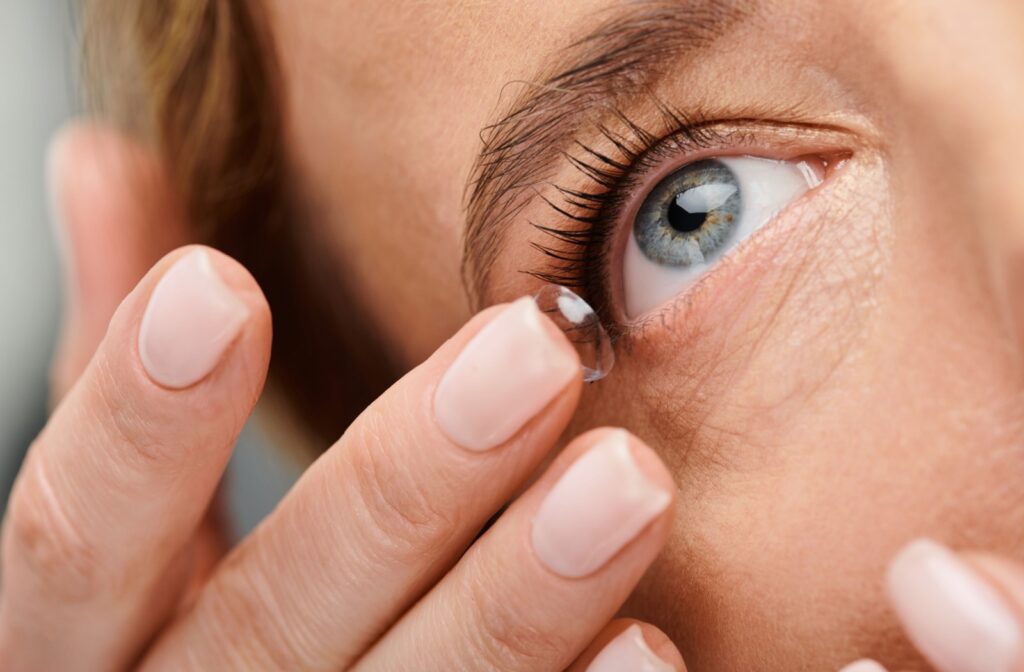Switching to contact lenses is an exciting step toward clear, glasses-free vision. That said, with new experiences comes an adjustment period, which applies to contact lenses too. With time, practice, and proper care, wearing contact lenses can feel as seamless and natural as wearing a pair of pants!
It can take around 7 to 10 days for your eyes to adjust to contact lenses.
With time, consistency, proper lens care, and an accurate contact lens fitting, settling into your new lenses can feel seamless. Don’t be discouraged if it takes a bit longer to adjust! Most new wearers report significant improvement within a week, and complete adjustment within 2 weeks.
Is Adjusting to Contact Lenses Normal?
Do not worry; adjusting to contact lenses is completely normal, especially if you’re new to them.
Think of it this way: even a new pair of prescription glasses takes some time getting used to. Glasses sit a few millimeters away from your eyes, resting on the bridge of your nose. Given that contact lenses interact directly with your eyes, this placement and sensation alone are bound to need a little time to settle into. Your eyes and brain simply need time to adapt to having the lenses resting on your eyes, on top of the slight differences in how the world looks compared to wearing glasses.
Here’s what you might expect during this period:
- Awareness of the lens: For the first couple of days, you may feel slightly aware of the lenses on your eyes. This is perfectly normal, and the sensation usually fades quickly.
- Mild dryness or irritation: Your eyes might feel dry as they adjust to the lenses. Artificial tears that are contact lens compatible can help.
- Adjusting vision: Contacts sit directly on the corneal surface, altering visual perception slightly. This can take a few days to get used to.
If wearing contacts feels odd or unusual, it’s okay. However, if you notice excessive discomfort, lingering redness, or blurry vision that doesn’t improve, it’s time to visit your optometrist for a closer look.
Key Factors Influencing Contact Lens Adjustment
On average, it can take about 7–10 days for your eyes to grow accustomed to contact lenses, but it varies from person to person.
A few factors influence this period, and understanding them can help you set realistic expectations and take steps to make the process smoother.
Type of Contact Lenses
There are different types of contact lenses, which vary in their duration of wear and material. Their unique features help accommodate different visual concerns and lifestyle preferences, so that more people can experience the benefits of contact lenses.
This also, however, plays a major role in how seamlessly you adapt to your lenses:
- Soft lenses are often easier to adapt to because they conform to the shape of your eye and are generally more comfortable.
- Rigid gas-permeable (RGP) lenses may take longer to get used to, but provide sharper vision. These lenses require more time for your eyes to adapt because of their firmer structure.
- Specialty lenses like toric or multifocal lenses, which correct specific vision concerns, may also extend the adjustment period because of their unique designs.
Wear Schedule
If you wear contact lenses for too long right from the get-go, this can lead to dryness, irritation, or even eye strain, slowing down the adjustment process.
Instead, wear your lenses for short periods on the first few days, then increase the duration gradually. For example:
- Day 1: 2–4 hours
- Day 2: 4–6 hours
By day 5, you should be able to wear them for a full day.
Eye Sensitivity
If your eyes are sensitive or if you have pre-existing conditions like dry eyes or allergies, this adjustment period may take longer.
Sensitivity can cause discomfort during the initial weeks of wear, making it essential to keep your eyes hydrated and clean. Switching to daily disposable lenses can also help.

Proper Lens Fit
We mentioned it briefly earlier, but contact lenses that fit perfectly make a significant difference in how comfortable they feel and how well they correct vision.
A contact lens should fit snugly on your eye, not too tightly or loosely, aligning properly with your cornea. This requires precise measurements, which we take during your contact lens fitting. We evaluate the shape and size of your eye as well as its health to find the correct lens size and type.
A well-fitted contact lens feels comfortable and also helps prevent complications.
Contact Lens Care
Since contact lenses sit directly on your eyes, they require pristine care.
Handle your lenses with clean, dry hands, and follow the manufacturer’s instructions for cleaning and storage. Always clean your lenses with proper contact lens solution, and never use tap water or saliva. These can introduce harmful irritants to the lens and increase your risk of infection.
Poor hygiene habits can lead to eye infections or discomfort, making it harder to get used to your lenses.
Lifestyle & Environment
Your daily activities and surroundings can also influence your adjustment. For example:
- Spending excessive time in dry, air-conditioned spaces may increase dryness.
- Activities that require extended focus, like computer use, can result in reduced blinking, leading to discomfort.
Taking breaks from screen time and using artificial tears can help mitigate these issues. If you stare at a screen for long periods, remember to blink frequently to keep your eyes moist.
If dryness persists despite these precautions, take a break from your contacts. It might be time to visit your optometrist to explore dry eye therapy.
Experience Lasting Comfort with Contacts
Correcting vision with contact lenses is popular for a reason! Many people prefer how comfortable and natural the lenses feel.
The right contact lens feels nearly invisible—you might even forget that you’re wearing them. That’s why a contact lens exam and fitting are essential for a comfortable and sharp visual experience.
Connect with Total Vision Solana Beach today and book your contact lens exam. Our experienced team is here to help you find the perfect lenses!



